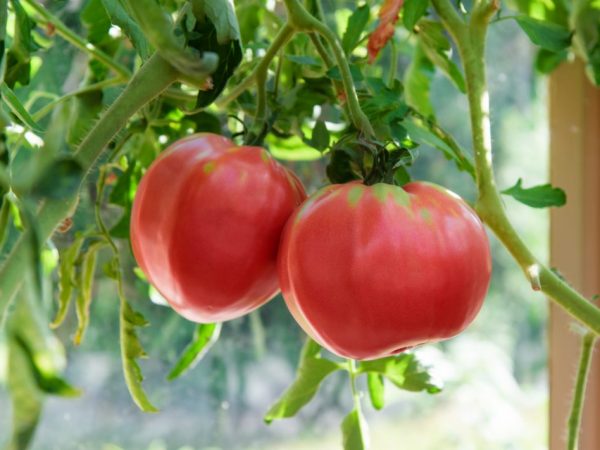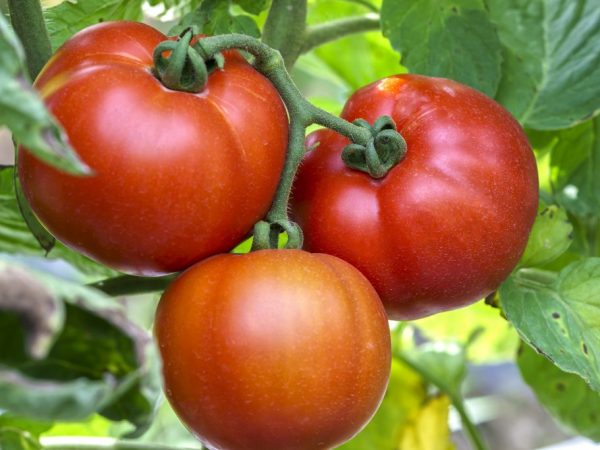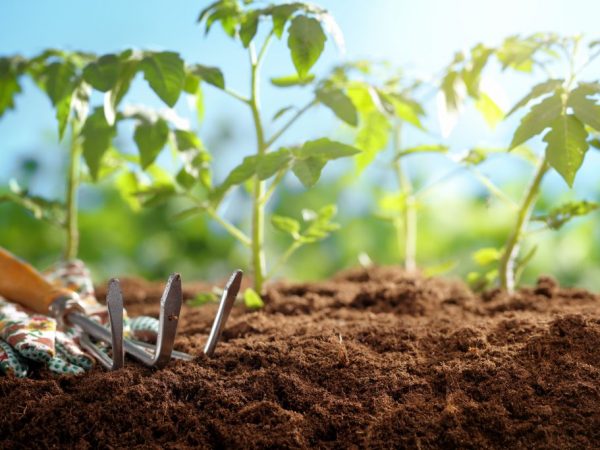Description of tomato Raspberry Giant
The Raspberry Giant tomato occupies an honorable place among the high-yielding early-ripening varieties. Its main features are its excellent taste and size. This is a real giant among other varieties of tomatoes.

Description of tomato Raspberry Giant
Tomato characteristic
Raspberry Giant tomatoes belong to the determinant early species. The bushes are large, the height varies from 50 to 100 cm. The stem is powerful, with dense foliage. Fan type bunches. Up to 12 bunches can be located on 1 bush. On average, you can get about 6 kg from 1 bush. The culture is moderately resistant to late blight.
Description of the tomato Raspberry Giant:
- the rhizome is well developed;
- during growth does not go deep into the ground;
- foliage is large, dark green;
- inflorescences are simple;
- 7-8 flowers are formed on inflorescences;
- the peduncle is well developed, with articulations;
Description of the fetus
Description of the tomato variety Raspberry Giant indicates that the fruits can be harvested after 90 days:
- fruits are large, do not crack when ripe;
- rounded tomatoes with irregularities, slight ribbing near the stalk;
- the weight of 1 fruit is 200-400g;
- the pulp is sweet with sourness.
Advantages and disadvantages
Tomato F1 Raspberry Giant has a lot of advantages over other species:
- suitable for making baby food;
- useful properties are retained even during heat treatment and lower temperatures;
- the skin has a thin, dense structure, so the fruits do not crack;
- fruits tolerate transportation well;
- the pulp is juicy;
- suitable for all types of preservation;
- moderately resistant to late blight.
The feedback from the farmers is mostly positive. There are practically no disadvantages of this type of tomato. Only 2 minuses were noted. The fruits cannot be preserved whole due to their large size. The second disadvantage is the impossibility of growing outdoors in the northern regions and the middle lane.
Growing
The yield of the variety is much better on fertile soils. The area for tomatoes should be well ventilated. Culture doesn't like drafts. Suitable for outdoor cultivation in southern areas. In other regions, it is advisable to place plants in greenhouses or greenhouses.

The plant thrives on greenhouse conditions
It is not recommended to plant tomatoes in areas after other nightshade crops. The precursors to tomatoes should be legumes or cucumbers. They begin to prepare the ground in the autumn. On the site, you need to collect all the roots and tops, burn them. Ash can be applied as fertilizer along with organic matter, and dug up a vegetable garden.
Seed preparation
The seeds are prepared immediately at harvest. For this, the largest, healthiest fruits are selected. The seeds must be carefully removed from the tomato and laid out on paper on a well-lit windowsill. You can also purchase seeds from a trusted supplier.
In the spring, the seeds are placed in a glass with a weak solution of manganese. This is necessary in order to disinfect the seed and reject empty seeds. Full seeds will settle to the bottom of the glass, while spoiled and hollow seeds will float. In addition to disinfecting treatment, it is advisable to spray the seed with growth stimulants in order to increase the yield.
Germination of seedlings
Seeds can be planted from late March to mid-April. They are planted in a common container, deepening by 2 cm, in increments of 2-4 cm. The soil temperature in the pot should be at least 25 ℃.
The soil needs to be compacted a little. Then the planting material must be watered with warm water and covered. Polyethylene can be used as a covering material. When the first shoots appear, the polyethylene should be removed and the pot should be placed in a well-lit room.
Watering is carried out as the soil dries up. When 2 full-fledged leaves are formed on the sprouts, they are transplanted into separate containers. It is recommended to feed the plants with mineral fertilizers. Landing in open ground is carried out at the end of June. 2 weeks before planting, you need to start hardening the seedlings, gradually reducing the air temperature in the room.
When the shoots are ready to be transplanted into the open ground, the stems turn blue at the base. In open ground, seedlings are planted at a distance of 50 -80 cm from each other. Fertilizer is placed in each hole. In the early stages of growth, tomatoes need phosphorus. Bushes of the Raspberry Giant variety require a mandatory garter, therefore, at the time of planting in open ground, you need to install supports next to the holes.
Care
Proper care of Raspberry Giant tomatoes includes a set of measures:
- watering;
- weeding;
- fertilization;
- garter;
- pinching.
Watering and feeding

Pieces should be watered as needed.
Plants should be watered as needed. Water must be poured at the root. The first time fertilization should be applied one week after transplanting.
Last year's foliage can be used as fertilizer. It is poured around the bushes. After some time, they will rot and nutrients will begin to flow into the ground. A manure solution is also used, which is periodically watered over the plants. Top dressing is stopped 3-4 weeks before the fruits ripen.
Loosening the soil
To increase yields, you need to regularly cultivate the soil between the rows. This helps to provide the root system with the required amount of oxygen. Weeding is carried out after precipitation and watering.
The heavier the soil, the deeper you need to loosen it. Along the way, weeds should be removed. The procedure must be carried out very carefully so as not to damage the root system.
Garter and pinning
For the garter, you need to prepare a dressing material that contacts directly with the stem. It is forbidden to use thread or wire. As it grows, tough materials will damage the stem and it may die. A cotton fabric cut into strips 10-15 cm wide is best. Before use, the fabric must be treated with a manganese solution.
There are a variety of accessories in stores today for tying and holding individual brushes. They are reusable. The garter helps the bushes to cope with the heavy weight of the fruit. It is also recommended to tie up individual bunches so that they do not break off the stem.
Raspberry Giant tomatoes require partial pinching. The ideal option is to form a crown in 2 stems. The leaves of the lower tier are to be removed before the first ovary. Grassing extra leaves allows you to accelerate the ripening process of fruits and improve their quality indicators. To get a good harvest, you need to leave up to 6 fruits in bunches.
Diseases and pests
The breeding characteristic describes the variety as resistant to many diseases.But, based on the experience of many gardeners, the variety is exposed to late blight, and like all nightshades, it is a favorite dish for the Colorado potato beetle. To prevent all kinds of fungal diseases, all seed material should be processed even before planting.
Throughout the season, plants are sprayed with various preparations that prevent the development of fungal spores. Viral diseases are often carried by insects, so it is very important to carry out treatment against parasites on time. Weeds can also be carriers. In the autumn, when cultivating the soil, you can add herbicides. These preparations completely destroy weeds and even the larvae of the Colorado potato beetle, which burrow into the ground for the winter to a depth of about 50 cm.
Conclusion
High yield and quality characteristics of the variety make Raspberry Giant tomatoes in demand among farmers in many countries. Growing this variety requires certain rules to be followed. The bushes can reach a height of one meter, therefore, when planting, a rather large distance should be left between the seedlings in order to provide free access and allow each plant to fully develop.
The culture is demanding about feeding. Bushes must be tied up and pinned. It is recommended to form a crown in 2 stems. The fruits are very large, some can reach a weight of 600 g, so they also need to be tied up and harvested on time.
The main advantage of the variety is its taste. The pulp of tomatoes is pink, fleshy, very juicy. Great for making all kinds of dishes, pasta, tomato and ketchup.

